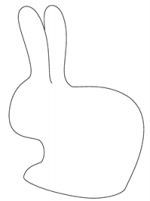The Rabbit is considered to be the luckiest of the 12 animals of the Chinese zodiac. Although the next Year of the Rabbit is not until 2023, a recent judgement from the Guangzhou IP Court suggests that 2020 may also be a prosperous year for the Rabbit.
The Guangzhou IP Court, one of three Chinese IP courts established in 2014 (the other two in Beijing and Shanghai), has recently issued a first-instance judgment in respect of a design patent infringement case brought by an Italian company, Giovannoni Design S.R.L (Giovannoni).
Giovannoni is owned by the world-renowned designers Elisa Gargan Giovannoni and Stefano Giovannoni who have designed iconic pieces for the likes of Alessi, Magis and Bertazzoni.
Giovannoni alleged that their Design Patent No. 303557311 was infringed by products sold by Boyuan Rotational Molding Technology Company (Boyuan). Boyuan specialise in the manufacture of glowing LED products, particularly furniture.
Design Patent No. 303557311 (Application No. 201530388869.3) was filed on 9 October 2015 and claims priority to European Application No. 002747345-0001 filed on 31 July 2015. The design is the work of Stefano Giovannoni and relates to a rabbit-shaped chair, as shown below:

Giovannoni sells chairs and also lamps made to this design under their brand Qeeboo.
Interestingly, Giovannoni also filed a further Chinese application (Application No. 201630160156.6; Design Patent No. 303938586) on 4 May 2016 showing the same design but this time with the brief description indicating that the product was a lamp, rather than a chair.
During the proceedings, Boyuan attempted to argue that their products were not chairs, but lamps. This raises the question as to why Giovannoni did not choose to enforce the later patent referring explicitly to lamps?
The answer to this appears to be as a result of a significant difference between European and Chinese laws which is worth bearing in mind: in Europe there is a 12-month grace period during which the applicant's own disclosures are not considered to form prior art against a later-filed application, but no such provision exists under Chinese law. Accordingly, Giovannoni's earlier application for the chair design would be citable against this later application under Chinese law, whereas it is not under European law.
Fortunately for Giovannoni this did not matter. Boyuan had described their product as being a chair on their website and so unsuprisingly this argument did not get them very far and the Judge found the products to fall within the scope of protection.
It is worth noting that under European law the indication of product given in the application does not affect the scope of protection as such. Accordingly, a registered design for a chair should also cover a lamp if visually they were the same (or sufficiently similar). Nevertheless, practitioners do sometimes include (as was the case here) different indications of product as a precaution since there may be situations where the indication of product could indirectly affect the scope of protection.
It is not clear whether the position is materially different in China. Article 59 of China's Patent Law states that "the scope of protection shall be confined to the design of the product as shown in the drawings or pictures, and the brief description may be used to explain the said design as shown in the drawings or pictures". Accordingly, while the brief description can be used to explain the design, it is not clear whether it would have limited the scope of protection to chairs only in this instance. The Judge did not need to consider this further in the present case and so, unfortunately, did not provide clarification on this.
There has historically been a belief that intellectual property rights are difficult to enforce in China, particularly for western businesses. This case goes further to dispel that myth and demonstrates that the Chinese IP Courts offer a fair and considered forum for litigants.
Boyuan has subsequently appealed the judgement to the Guangdong High Court. It will be interesting to see how this case develops and whether any of the points raised here are explored in further detail in the appeal.
The content of this article is intended to provide a general guide to the subject matter. Specialist advice should be sought about your specific circumstances.

